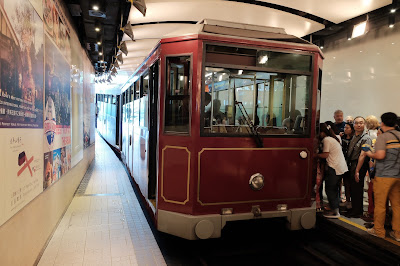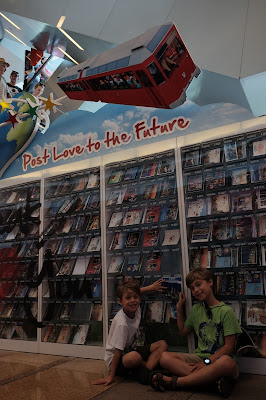The train actually stopped in Shenzhen, a large city right at the border between mainland China and the Special Administrative Region of Hong Kong. After arriving at the Shenzhen North Railway Station, we took the subway south to the Futian Checkpoint Station.
We exited the Shenzhen subway, passed through Chinese immigration in order to exit mainland China, walked across a bridge into Hong Kong, and then passed through Hong Kong immigration. After a couple of hours and all the formalities of border crossings (i.e., waiting in lines and tiny forms), we officially entered Hong Kong and got right on the Hong Kong subway system.
While we'd researched the route and knew what to expect, this whole arrangement was a bit confusing to us since Hong Kong is technically part of China.....right? Well, yes....and no. Hong Kong was a British colony until it was returned to China in July 1997. Even though it is now part of China, for now Hong Kong maintains separate economic and legal systems, part of the "One China, Two Systems" doctrine. Hong Kong oversees its own immigration policies (hence the official border crossing) and has its own currency and flag.
After getting settled in and resting for a bit at our hotel, we made our way to the Tsim Sha Tsui Promenade in order to view the iconic Hong Kong skyline at night. We arrived just before what is billed as the world's largest permanent light and sound show. It was OK, but it was the skyline itself that was impressive.
The next day, we took the Star Ferry across Victoria Harbor. This ferry line runs between Hong Kong Island and Kowloon, and it offered some fantastic day views of the skyline of the Central district of Hong Kong.
We then did a short walking tour of the Central district, which took us past some of the most important landmarks in this part of Hong Kong. There was colonial architecture juxtaposed with modern skyscrapers.
This was St. John's Cathedral, a small but beautiful church along our walking tour.
In one of the small parks in the city, we saw the same tree with enormous leaves that we saw in Chengdu, but this time with a sign telling us its name--turns out it's called a Traveler's Tree. We all really love these trees, so the name is quite appropriate.
This was one of our favorite buildings...it looked like big puzzle pieces stacked on top of each other.
We stopped in the Flagstaff House of Museum of Tea Ware, a museum dedicated to tea production, tea pots, and tea culture. Tea was not something we'd previously thought a lot about (other than Bob and I drinking it from time to time), but we all thought the museum was very interesting.
We stopped in at a tiny restaurant (all of 4 tables) to have dim sum. We tried a variety of dishes that were all delicious.
The next day, we waited with the masses to take the funicular to the top of Victoria Peak, which towers high above the rest of Hong Kong.
At the top, there was a station where you could put a postcard in a dated box so that it's mailed sometime in the future. We wrote ourselves a postcard that will be mailed in exactly one year.....when we anticipate having new jobs, a new location, a new house, maybe a dog.......so definitely a different stage of life than right now.
From there, we enjoyed a fantastic pizza lunch with beautiful views of the Hong Kong skyline.
Then we walked around Victoria Peak, taking in the views a bit more. Colin was more than done taking photos, so it looks like we only have one child here.
We made our way back to our hotel to relax a bit and enjoy the pool. Hong Kong is a hot and humid place--I think the humidity was something like 87% this day.....basically, sauna-level.
The next day, we departed bright and early on a day trip. From Hong Kong, we took an hour-long hydrofoil ferry ride through the South China Sea to Macau, another Special Administrative Region.
Macau was a former Portuguese colony that was returned in China in December 1999 and, like Hong Kong, it has retained its own system of governance, as well as its own currency and flag.
Walking through Macau felt like a time/location warp back into Europe because the architecture was so very Mediterranean, and everything is written in Portuguese (and Chinese). We especially loved the beautiful tile streets and walkways.
The Ruins of St. Paul's, what's left of a 16th century complex of buildings, are one of the must-see sights in the center of Macau.
Across the street is the Fortaleza do Monte, a fort built in the 1600s to protect the Jesuits (who were living in Macau) and their properties from pirates. It was also crucial in defending Macau from an attempted invasion by the Dutch in 1622. Now it's interesting to see the historical fortress juxtaposed with the massive casinos that really define the Macau skyline.
Within the fort was the excellent Museum of Macau. What we thought would be a quick visit turned into multiple hours during which we learned a lot about the history of Macau and the culture of its people. This was an exhibit highlighting the different architectural styles of Macau, from traditional Chinese to colonial Portuguese.
And this was my absolute favorite sign of the whole museum.....the etymology of the word "tea". The word your language uses to refer to "the stuff you steep and drink" depends on who introduced this previously-unknown substance to your culture: the Portuguese (who were introduced to tea by Cantonese traders, so they called it "tcha" and used this word along their trading routes) or the Dutch (who were introduced to tea by traders from Amoy, who called it "tay", and so the people along former Dutch trading routes use some variant of this word). Fascinating!!
Finally, we went to the top of Guia Hill, the highest point in Macau. At the top is the Guia Fortress, built in the 1600s after those pesky Dutchmen tried to capture colonial Macau from the Portuguese. In the 1800s, a lighthouse was also built, which was the first Western-style lighthouse in east Asia or on the Chinese coast.
Inside the complex, there was a small display of typhoon warning pieces. Each one of these signifies an increasingly bad weather condition (similar to tropical storm and hurricane levels). If typhoon weather is approaching, these exact pieces are raised above Guia Fortress to warn the Macanese people of impending bad weather conditions.
While waiting for the ferry back to Hong Kong, Colin entertained us with his dance moves. It all began when he asked for our deck of playing cards (made by the "Bin Wang" company), and this is a video of him strutting his stuff...
The next day we had a "maintenance day". This is what we've started calling days when we don't necessarily do any sight seeing and instead take it easy and/or take care of things that need to get done (haircuts, shopping for supplies, etc). On this day, we slept in, mailed a box back to the States, made phone calls, got paperwork ready for our upcoming travel to Vietnam, swam in the pool.......and that was it. We like to get out and do things, but sometimes a day of nothing in particular is exactly what we need.
The next day was our last in Hong Kong since we were scheduled to depart on a late night flight to Hanoi, Vietnam. For our last day, we headed to the Hong Kong Science Museum. There was a great temporary exhibit called "Grossology" that featured exhibits on blood, poop, slime, and other gross things that 10 and 7 year olds find absolutely fascinating.
We also went through the museum's permanent exhibits and had a great day.
From the Science Museum, we headed back to our hotel to pick up our bags, and then we went on to Hong Kong International Airport to catch our flight to Hanoi, Vietnam!


























































































